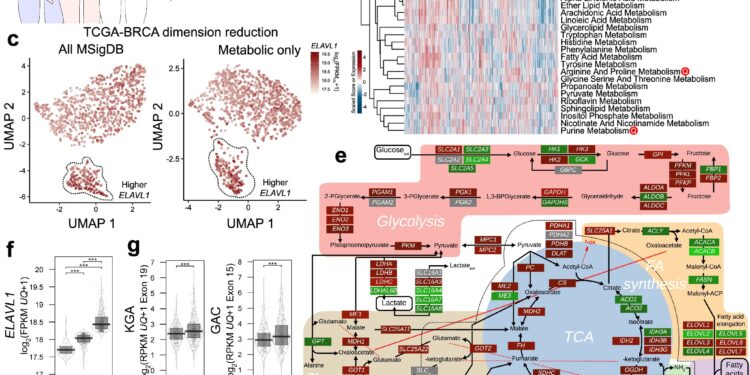ELAVL1 expression is increased in several tumors and is directly linked to GAC and KGA mRNA levels. Credit: Natural communications (2024). DOI: 10.1038/s41467-024-49874-x
A study carried out by Brazilian researchers and reported in an article published in the journal Natural communications proposes that simultaneous targeting of the glutaminase enzyme and the HuR protein, both essential for tumor progression, may be effective in the treatment of breast cancer.
The metabolic requirements of tumor cells are associated with high levels of glutamine consumption for energy. The first step is the conversion of glutamine to glutamate catalyzed by glutaminase, which has three isoforms (GAC, KGA and LGA) with different relationships with tumor progression, and is a good treatment target, according to the researchers.
“Glutaminase is important because it converts glutamine into compounds that fuel the cell’s energy production and supply cycle. This makes it essential for cancer cells, which have a very active metabolism to maintain rapid growth,” said Douglas Adamoski, first author of the paper with a Ph.D.
Glutaminase inhibition is therefore a common target for cancer treatment, but researchers have innovated by focusing on how HuR regulates glutaminase RNA metabolism as a strategy to improve its effectiveness.
“Another important aspect of the study was a groundbreaking investigation into the role of HuR in the overall control of cellular metabolism. The paper shows how it regulates tumor cell metabolism by affecting key metabolic genes. This includes pathways such such as glycolysis, the Krebs cycle and fatty acid synthesis, for example,” said Sandra Martha Gomes Dias, a researcher affiliated with the Brazilian Center for Energy and Materials Research (CNPEM).
High levels of HuR correlate with increased expression of genes related to cancer cell proliferation and survival, suggesting poor patient prognosis. The regulation of this protein could therefore also constitute a promising therapeutic target.
“Small molecule HuR inhibitors have been identified and new formulations for targeted delivery to tumor cells have been developed with promising anticancer activity,” Dias said.
Isoforms
The results show that HuR, which is often overexpressed in cancer patients, plays a critical role in ensuring the correct isoform of glutaminase is produced.
“When HuR levels are low, GAC production increases to convert glutamine to glutamate more quickly,” Adamoski said.
To reduce HuR expression, the researchers reduced the KGA isoform and increased GAC, making cancer cell metabolism even more dependent on glutamine than usual.
“By reducing HuR and at the same time chemically inhibiting glutaminase, we were able to cause a significant decrease in the growth and invasion of breast cancer cells,” he said.
Other co-authors of the study are researchers affiliated with CNPEM and the State University of Campinas (UNICAMP) in Brazil, the University of Washington School of Medicine, and the University of Texas at United States, as well as at the Iuliu-Hatieganu Medical University in Romania.
The results suggest that the combination of glutaminase inhibition and HuR could be an effective strategy for the treatment of breast cancer. They point to conclusions similar to those of a previous study, in which Dias and Adamoski also participated and on which an article was published in Nature Structural and molecular biology.
This previous study elucidated the mechanisms by which glutaminase activity intensifies via filament formation in mitochondria. This finding is important because dysregulation of tumor metabolism plays a key role in cancer and metastasis and is associated with poor prognosis for breast cancer patients.
More information:
Douglas Adamoski et al, HuR controls glutaminase RNA metabolism, Natural communications (2024). DOI: 10.1038/s41467-024-49874-x
Quote: Breast cancer strategy involves two-pronged attack on enzyme that ‘feeds’ tumor (September 27, 2024) retrieved September 27, 2024 from
This document is subject to copyright. Except for fair use for private study or research purposes, no part may be reproduced without written permission. The content is provided for informational purposes only.



